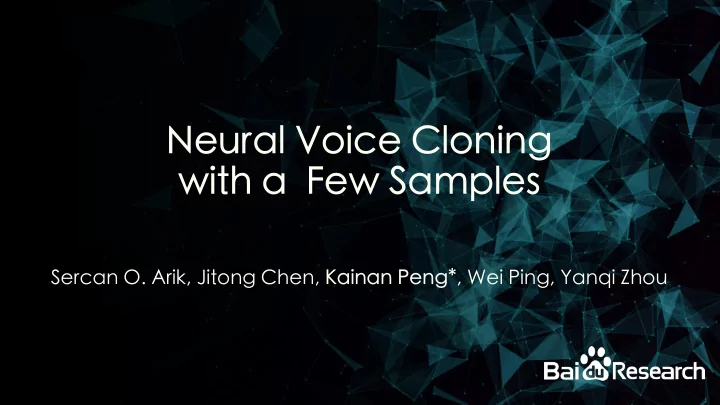

Neural Voice Cloning with a Few Samples Sercan O. Arik, Jitong Chen, Kainan Peng* , Wei Ping, Yanqi Zhou
Motivations • Text-to-speech (TTS) models can be conditioned on text and speaker identity. • Text: linguistic information, content of the generated speech. • Speaker identity: speaker information (accent, pitch, speech rate…).
Motivations • Text-to-speech (TTS) models can be conditioned on text and speaker identity. • Text: linguistic information, content of the generated speech. • Speaker identity: speaker information (accent, pitch, speech rate…). • Limitations: • Can only generate speech for observed speakers during training. • Require lots of speech samples per speaker (e.g., Deep Voice 2).
Voice Cloning • Voice cloning: synthesize the voices of new speakers from a few speech samples (few-shot generative model). • Applications: personalized speech interfaces, content creation, assistive technology…
Voice Cloning • Voice cloning: synthesize the voices of new speakers from a few speech samples (few-shot generative model). • Applications: personalized speech interfaces, content creation, assistive technology… • Challenges: • Generalization: learn the voice of a new speaker. • Efficiency: extract the speaker characteristics from a few speech samples. • Computational cost: cloning with low latency and small footprint. • Two approaches: • Speaker adaptation. • Speaker encoding.
Speaker Adaptation • Fine-tune a pre-trained multi-speaker model for a new speaker. • Training data: a few text and audio pairs.
Speaker Adaptation • Fine-tune a pre-trained multi-speaker model for a new speaker. • Training data: a few text and audio pairs. • Two options for speaker adaptation: Fine-tune the whole model Fine-tune the speaker embedding only
Speaker Adaptation Analysis Speaker Adaptation Approaches Embedding-only Whole-model Cloning time 8 h 5 min # of parameters 128 25 million per speaker
Speaker Encoding • Directly predict a new speaker embedding for a multi-speaker model. • Train a speaker encoder with audio and speaker embedding pairs.
Speaker Encoding • Directly predict a new speaker embedding for a multi-speaker model. • Train a speaker encoder with audio and speaker embedding pairs. • Cloning time: a few seconds, more favorable for low-resource deployment.
Results • Vocoder: classical Griffin-Lim algorithm. • Demo website: ht http://au audiodemos.g .github.i .io Speaker Adaptation Speaker Approaches Encoding Embedding-only Whole-model Naturalness 2.67 3.16 2.99 (5-scale) Mean Opinion Score (MOS) Similarity 2.95 3.16 2.85 (4-scale)
Voice Morphing via Embedding Manipulation • BritishMale + AveragedFemale - AveragedMale = BritishFemale • BritishMale + AveragedAmerican - AveragedBritish = AmericanMale
Thank you! Welcome to our poster, and listen to samples! Today, Session B, #91
Recommend
More recommend